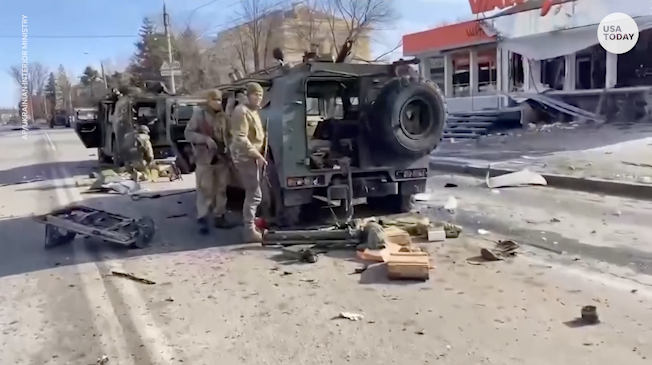
Kharkiv invaded by Russian troops as residents hide in bomb shelters
President Putin ordered Russian nuclear forces to be on high alert as Kharkiv, Ukraine’s second-largest city, is assaulted by Russian troops.
Patrick Colson-Price, USA TODAY
WASHINGTON – The Pentagon will likely continue to send an array of weaponry to Ukrainian forces even if Russian troops seize the capital of Kyiv, military analysts say, and could calibrate the lethality of those arms based on Russian President Vladimir Putin’s willingness to negotiate an end to the war.
The shipments, combined with a Ukrainian resistance described as fierce and creative Sunday by a senior U.S. Defense Department official , will continue to pose a substantial threat to Russian forces, even if they occupy Kyiv and other major cities, analysts say.
There have been no signs that the Russians have blocked or impeded military aid shipments from the west to Ukrainian armed forces, the Defense official said, speaking on condition of anonymity to discuss intelligence findings. Shipments from the United States and other countries are accelerating and increasing, the official said, declining to say how they are being delivered to insure the weapons get into the hands of Ukrainian armed forces.
Why is Russia invading Ukraine?: Could it be the start of WWIII? Here’s what we know
The Russian force of more than 150,000 troops deployed by Putin already has experienced its own problems with fuel and resupply, the official said. Ukrainian resistance has stymied the Russian advance in the fourth day of the war, the official said, and in some cases Russia has been slowed by its own logistical problems. Russia has yet to occupy any of Ukraine’s major cities despite overwhelming advantages in weaponry.
Russia-Ukraine explained: Inside the crisis as US calls Russian movements an invasion
This is combat, the U.S. official said: ugly, messy and unpredictable.
There is some risk that using U.S. and other Western arms to kill Russian soldiers could escalate the war, said Seth Jones, senior vice president and director of the international security program at the Center for Strategic and International Studies.
But he noted that the U.S. provided weapons to insurgents in Afghanistan who took a heavy toll on troops from the Soviet Union after the Soviets invaded in 1979. The Russians supplied limited arms to the Taliban to use against U.S. troops, and Iran supplied Shiite insurgent groups with weapons to attack U.S. troops in Iraq.
“All without major blow back,” Jones said, concluding the risk for the United States is worth taking.
Closing Ukraine’s western border, though which military aid has been flowing, seems beyond Putin’s reach, analysts said.
Live: Mapping and tracking Russia’s invasion of Ukraine
On Saturday, the Pentagon announced a $350 million emergency package of equipment to Ukraine. That included Javelin anti-armor missiles, ammunition, body armor and other equipment. In the last year, the Pentagon has provided $1 billion in military aid to Ukraine.
Anti-tank weapons such as the Javelin and Stinger surface-to-air missiles would provide Ukrainian forces significantly better capabilities than the Iraqi and Afghan insurgents who fought U.S. forces, Jones said.
Pentagon officials have declined to say whether anti-aircraft missiles have been provided to Ukrainian forces. However, Germany announced this weekend it will send weapons to Ukraine that include 500 Stinger missiles and 1,000 anti-tank weapons. Last month, NATO’s Baltic allies said they had been shipping Stinger missiles to Ukraine as well.
“These weapons will be extremely useful even if Russian forces are able to seize cities like Kyiv and Ukrainian forces shift to insurgent operations,” Jones said.
The Pentagon could ship an arsenal to Ukrainian forces that includes anti-tank missiles such as the NLAW, a shoulder-fired weapon similar to the Javelin made by European allies, Jones said. Other weaponry could include surface-to-air missiles to destroy Russian helicopters and other aircraft and anti-ship missiles such as Harpoons. Russia has deployed warships, including troop-carrying amphibious landing craft in the Black Sea, which lies along Ukraine’s southern border.
Sanctions hit Russia’s yacht-owning clas: Will that blunt Putin’s Ukraine invasion?
Drones, systems for electronic warfare and cyber defense are other options.
Basic supplies for troops in combat could also be considered, Jones said, citing small arms and artillery, ammunition, spare parts for vehicles and aircraft spare parts, fuel, rations and medical support.
“Ukraine’s western borders are open for business,” Jones said. “Russia would have to shut those borders down to stop the flow of weapons, and they aren’t even close to doing that.”
It will be critical to link Western military assistance to a diplomatic strategy for ending the war, said Michael O’Hanlon, senior fellow and director of research in foreign policy at the Brookings Institution.
“The question is, are we seeing the urgency of ending this, or are we letting Putin stew in his juices?” O’Hanlon said. “The latter approach is tempting. The former is smarter.”
from USA News – usanewsplug https://ift.tt/wHVO5oc
via IFTTT
